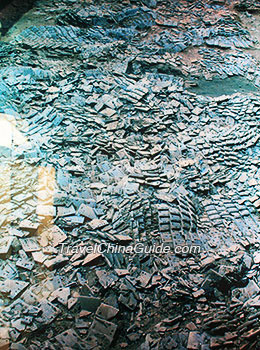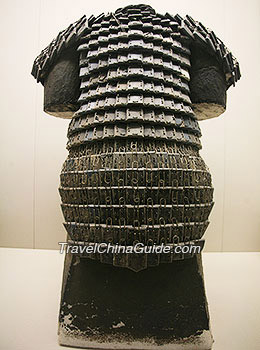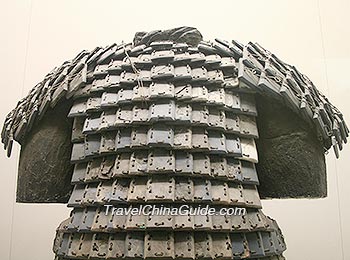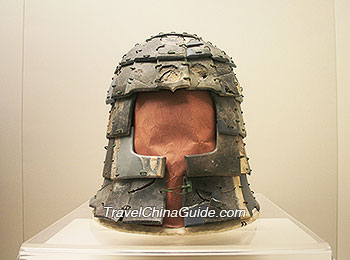Pit K9801 – Stone Armor and Helmets
The accessory pit K9801 of Qin Shi Huang Mausoleum was first discovered by a farmer of the nearby Xiachen Village in 1996. The unearthed relics are mainly stone armor and stone helmets, so people also call it Stone Armor Pit. The pit is not open to the public at present, but the relics discovered there are exhibited in the Exhibition Hall of Historical Relics of Emperor Qin Shihuang's Mausoleum, which is not far from the Terracotta Army. Admission is included with the through ticket for the Terracotta Army.
Pit K9801 is located in the southeastern part of the Qin Shi Huang Mausoleum between the inner and outer city walls, about 200 meters (219 yards) away from the mausoleum mound. The layout structure looks like a rectangle, 130 meters (142 yards) long from north to south, and 100 meters (109 yards) wide from west to east, with an area of more than 13,000 square meters (3 acres) in total, even larger than the most famous Pit 1. Pit K9801 is the largest among the accessory pits discovered inside the Qin Shi Huang Mausoleum to date.
From June 1998 to January 1999, the archaeological team did a lot of excavating work in this huge pit. It was estimated that five million pieces of stone armor and helmets as well as other military equipment were buried underground. At present, the excavated area is about 153 square meters (183 square yards). Archaeological workers have found many recognizable stone relics including 87 pieces of armor, 43 helmets and 3 bridle reins.
Because of the limited area excavated so far, it’s hard to judge the function of pit K9801. Some archaeologists think it is the arsenal pit of the first emperor’s mausoleum, some think it is a kind of military establishment. In any case, the discovery of these helmets broke the rumor that the Qin army did not use helmets.
According to their characteristics and appearance, these unearthed pieces of stone armor are divided into three distinct categories: one with oblong or square-shaped stone pieces in relatively large sizes, one with fish scale-shaped stone pieces in smaller sizes, and one for horses. The horses’ stone armor is suitable for carriage horses and cavalry horses respectively.
The stone helmets are mainly of two types: one with larger curved stone pieces thought to be imitating the real leather helmet of that time and one with smaller stone pieces modeling after the iron helmet.
The exquisite stone armor and helmets adopted high-quality technology in their creation. Their basic material is bluestone from Manding Village, Fuping County, Weinan City, about 75 kilometers (47 miles) from the mausoleum site. The processing steps were:
1. Make small stone pieces.
2. Shape the stone pieces. They can be rectangular, circular, trapezoidal, and cambered, because of their various positions on stone armor or helmets.
3. Polish the stone pieces and drill holes. The thinnest stone pieces are only 2 – 3 mm (0.08 – 0.11 inches) and in some of them, people can find as many as 10 holes.
4. String the stone pieces together with flat copper wires.
Through experiment, it took one person about 344 – 444 days and 8 hours a day to finish a stone armor with about 600 stone pieces. Considering the five million stone pieces in pit K9801, you can imagine what a large group of people have been involved in the construction work of the mausoleum.
Scholars believe that the stone armor and helmets here are not real ones used in battle. One of the reasons is that the complicated crafting process is difficult for mass production, and the other is that based on the research, the weight of each set of stone armor clothing is about 25 kilograms (55 pounds), which is impossible to wear for long, let alone to fight in a war. However, this stone armor shows a real form and style of armor in the Qin Dynasty (221 BC – 207 BC).
 More Accessory Pits:
More Accessory Pits:
 Pit K0006 - Civil Official Figures
Pit K0006 - Civil Official Figures
 Pit K9901 - Acrobatics Figures
Pit K9901 - Acrobatics Figures
 Pit K0007 - Bronze Aquatic Birds
Pit K0007 - Bronze Aquatic Birds
 Further Reading: Why are there partition walls in the pit of Terracotta Army?
Further Reading: Why are there partition walls in the pit of Terracotta Army?
Pit K9801 is located in the southeastern part of the Qin Shi Huang Mausoleum between the inner and outer city walls, about 200 meters (219 yards) away from the mausoleum mound. The layout structure looks like a rectangle, 130 meters (142 yards) long from north to south, and 100 meters (109 yards) wide from west to east, with an area of more than 13,000 square meters (3 acres) in total, even larger than the most famous Pit 1. Pit K9801 is the largest among the accessory pits discovered inside the Qin Shi Huang Mausoleum to date.
|
|
Current Excavation State
Because of the limited area excavated so far, it’s hard to judge the function of pit K9801. Some archaeologists think it is the arsenal pit of the first emperor’s mausoleum, some think it is a kind of military establishment. In any case, the discovery of these helmets broke the rumor that the Qin army did not use helmets.
Various Types of Stone Armor and Helmets
The stone helmets are mainly of two types: one with larger curved stone pieces thought to be imitating the real leather helmet of that time and one with smaller stone pieces modeling after the iron helmet.
|
|
Four Steps to Make Stone Armor and Helmets
1. Make small stone pieces.
2. Shape the stone pieces. They can be rectangular, circular, trapezoidal, and cambered, because of their various positions on stone armor or helmets.
3. Polish the stone pieces and drill holes. The thinnest stone pieces are only 2 – 3 mm (0.08 – 0.11 inches) and in some of them, people can find as many as 10 holes.
4. String the stone pieces together with flat copper wires.
Through experiment, it took one person about 344 – 444 days and 8 hours a day to finish a stone armor with about 600 stone pieces. Considering the five million stone pieces in pit K9801, you can imagine what a large group of people have been involved in the construction work of the mausoleum.
Stone Armor and Helmets - Imitations of the Real Ones of the Qin Dynasty
- Last updated on Aug. 14, 2024 by Catherine He -



